When a migraine headache hits, it can rapidly become debilitating. It’s as if the world stops and all we can think about ending the pain as soon as possible. Our ‘quick fix’ culture tells us there’s no better option than popping a pill for fast, effective relief from migraines (or minor headaches, for that matter). This simply is not the case. In fact, there are drug-free alternatives, including acupuncture and pressure points for migraines that are proven to work better than medications.[1]
Migraine headaches have many different causes. These include everything from environmental factors – like air quality, climate, and food sensitivities – to lifestyle aspects like nutritional deficiencies, stress, and physical inactivity. Hormone fluctuations are another known contributing factor for migraines, especially in women.[2]
This goes way deeper than the dull throbbing of a headache. Migraine sufferers can experience additional symptoms associated with these headaches. Getting to the root is helpful, but you can tailor immediate relief to these specific migraine symptoms.
Choosing the Best Pressure Point For Your Migraine Symptoms
Migraine-associated symptoms vary widely from person to person and across each individual’s spectrum of episodes. This can cause confusion and frustration for sufferers seeking reliable treatment solutions.
Symptoms can include, but are not limited to, sensitivity to light, sound, and smells; intense vice-grip-like pain in the forehead, neck, face, and eyes; nausea and/or vomiting; neck stiffness; lightheadedness/dizziness; nasal congestion; irritability; and ocular auras (visual migraine symptoms including light flashes, zigzagging patterns, blind spots, or ‘stars’/shimmering spots).
Some of these symptoms can even be worsened by over-the-counter headache medicines or pharmaceutical migraine treatments.[3] Thankfully, acupuncture can provide both prevention and treatment of several headache types, including migraine.[4]
IMPORTANT NOTE: Acupuncture (using insertion of needles) must be performed by a licensed professional. For self-treatment, you can use the pressure points listed in this article to apply acupressure (firm pressure on a specific median/nerve point).
How Does Pressure Point Treatment Work?
Acupuncture is an ancient method practiced by traditional Chinese medicine (TCM) healers for thousands of years. It uses application of needles to specific points along meridians (energy channels that run beneath the surface of the body). There are 14 meridians, which have long been known and treated by various Eastern practitioners, including those of TCM as well as yoga therapy.
Acupressure is an alternate form of stimulating these energy channels. Instead of inserting needles, the points are activated by using firm pressure and/or massage with the fingers. When a pressure point is pressed, that impression travels along the meridian and directs energy throughout the body.
Dr. Dharma Singh Khalsa explains from a yogic perspective in his book, Meditation as Medicine,
“For thousands of years, yogic healers have prescribed various postures and movements to change the energy flow of the meridians and help people heal.”
In other words, their technique may be slightly different, but the functionality and outcomes are congruent with TCM’s practice of meridian stimulation therapy.
He adds,
“From the Western perspective, the postures and movements activate the calming, parasympathetic branch of the nervous system, which releases chemical milieu [environment] that produces relaxation.”
In fact, Western medicine is beginning to catch up and has been able to document the existence of these channels through modern medical technology such as MRI and CT scans.[5] One theory of the effectiveness of this practice is that pressure on certain points actually reduces stress hormone levels in the nerves.[6]
At the core of this practice, regardless of origin or discipline, is the understanding that all forms and functions of the human body are interconnected. This means that it’s possible to stimulate one part of your body to activate or align another body part. It also means that we can activate calming in our nervous system via manipulation of specific external touchpoints. Relaxation is a key component for pain relief, especially as related to migraines.
8 Pressure Points for Effective Migraine Relief
Manage migraine headaches fast with these proven symptom-specific pressure points:
1. For Migraine with Dizziness, Anxiety, and/or Fatigue
- Pressure Point: GV20
- Pinyin Name / English Translation: Baihui / Hundred Meetings (Convergence), Governor Vessel
- Location: Highest point of the head.
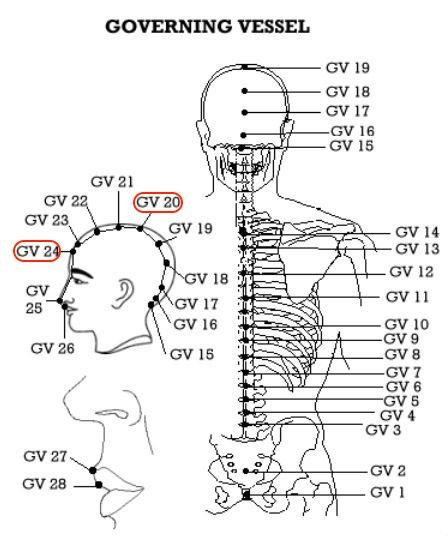
Draw an imaginary line from the center of your forehead back toward the base of your neck. Draw another imaginary line from the top of your left ear over to the top of your right ear. The point at which these two lines intersect is GV20.
2. For Migraine With Dizziness, Anxiety, And/or Runny Nose
- Pressure Point: GV24
- Pinyin Name / English Translation: Shenting / Mind Courtyard (Spirit Court)
- Location: Half a thumb’s width above the hairline at the mid-forehead. Please refer to the infographic for point #1 above for the pressure pouint GV24.
3. For Migraine With Dizziness And/or Vomiting
- Pressure Point: GB8
- Pinyin Name / English Translation: Shuaigu / Leading Valley
- Location: Above the top of ear, two forefingers’ width into hairline.
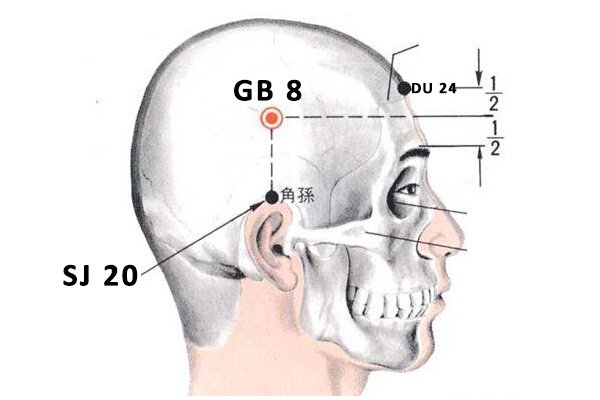
4. For Migraine With Eye Pain, Facial Pain, Ringing in Ears (Tinnitus)
- Pressure Point: SJ20
- Pinyin Name / English Translation: Jiaosun / Minute Angle (Angel Vertex)
- Location: Directly above the top of ear, at the hairline. Please refer to the infographic for point #3 above for the pressure pouint SJ20.
5. For Migraine With Dizziness, Neck Stiffness, Eye Pain, Aura/Vision Disturbances, Congestion
- Pressure Point: GB20
- Pinyin Name / English Translation: Fengchi / Wind Pond
- Location: Base of skull, just at the top of the back of neck, in the soft depressions to either side of the thick trapezius tendons.
To find it easily, make a triangle shape with your hands in front of you (thumb tips touching to form the bottom, index fingers touching at top to form the side angles, palms facing away from you).
Keeping your hands in this position, move them behind your head and place your thumbs at the base of your skull. Slide your thumbs apart in a downward motion, past the base of your skull and you should feel two slight indents on either side of the vertebrae, in your neck muscles.
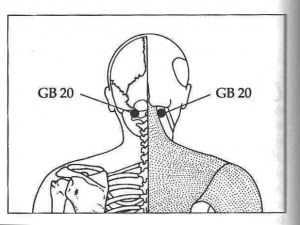
6. For Migraine With Tension, Anxiety, Irritability, And/or Menstrual Pain
- Pinyin Name / English Translation: Shenmen / Spirit Gate
- Location: Upper part of each ear in the triangular-shaped valley.
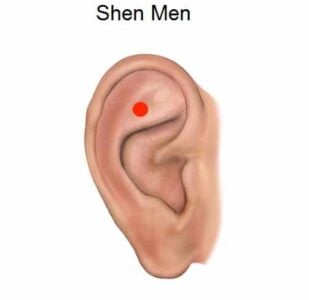
7. For Migraine With Tension/Pressure in Neck and Head; Pain in Face, Neck, Sinuses, Jaws, And/or Ears
- Pressure point: LI4
- Pinyin Name / English Translation: Hegu, Joining (Union) Valley
- Location: In the web or fleshy depression between the thumb and the index finger.

8. For Migraine With Pain in the Back of Head, Neck Pain, Earache
- Pressure Point: SI3
- Pinyin Name / English Translation: Houxi, Back Stream (Ravine)
- Location: The outer blade of the hand, in the depression of the hand just below the pinkie finger.
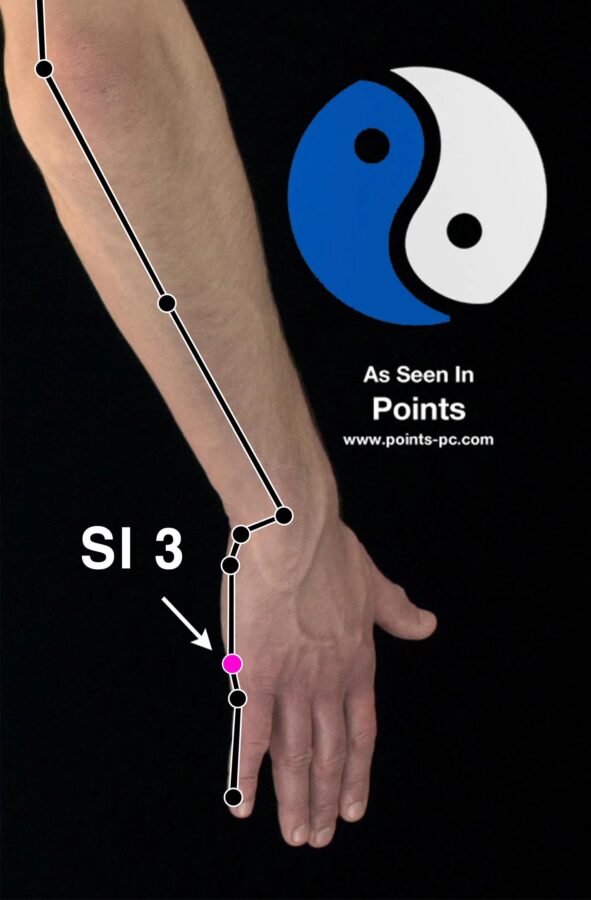
Natural Migraine Relief Remedies for the Win
It can be tempting to run to the medicine cabinet every time we are hit with the agonizing pain and discomfort of a migraine. Thankfully quick, effective migraine relief without troublesome side effects is possible, using little more than our fingers.
Reference the proven pressure points above next time you’re suffering from a migraine. You’ll be happy to get easily accessible relief to all of your migraine symptoms, no pills required.
Featured photo credit: Hermes Rivera via unsplash.com
Reference
| [1] | ^ | Neurology and Therapy: Acupuncture and Its Role in the Treatment of Migraine Headaches |
| [2] | ^ | The Journal of Headache and Pain: Migraine in women: the role of hormones and their impact on vascular diseases |
| [3] | ^ | Journal of Neurology: Acupuncture versus propranolol in migraine prophylaxis: an indirect treatment comparison meta-analysis |
| [4] | ^ | HEADACHE The Journal of Head and Face Pain: Role of Acupuncture in the Treatment or Prevention of Migraine, Tension-Type Headache, or Chronic Headache Disorders |
| [5] | ^ | Evidence-Based Complementary and Alternative Medicine: Locating the Acupoint Baihui (GV20) Beneath the Cerebral Cortex with MRI Reconstructed 3D Neuroimages |
| [6] | ^ | Applied Nursing Research: Auricular acupressure reduces anxiety and burnout in behavioral healthcare |
The post Migraine Headaches: 8 Pressure Points For Migraine Relief appeared first on Lifehack.
Did you miss our previous article...
https://rsssuperfeeds.com/life-hacks/9-diy-mini-greenhouse-ideas






